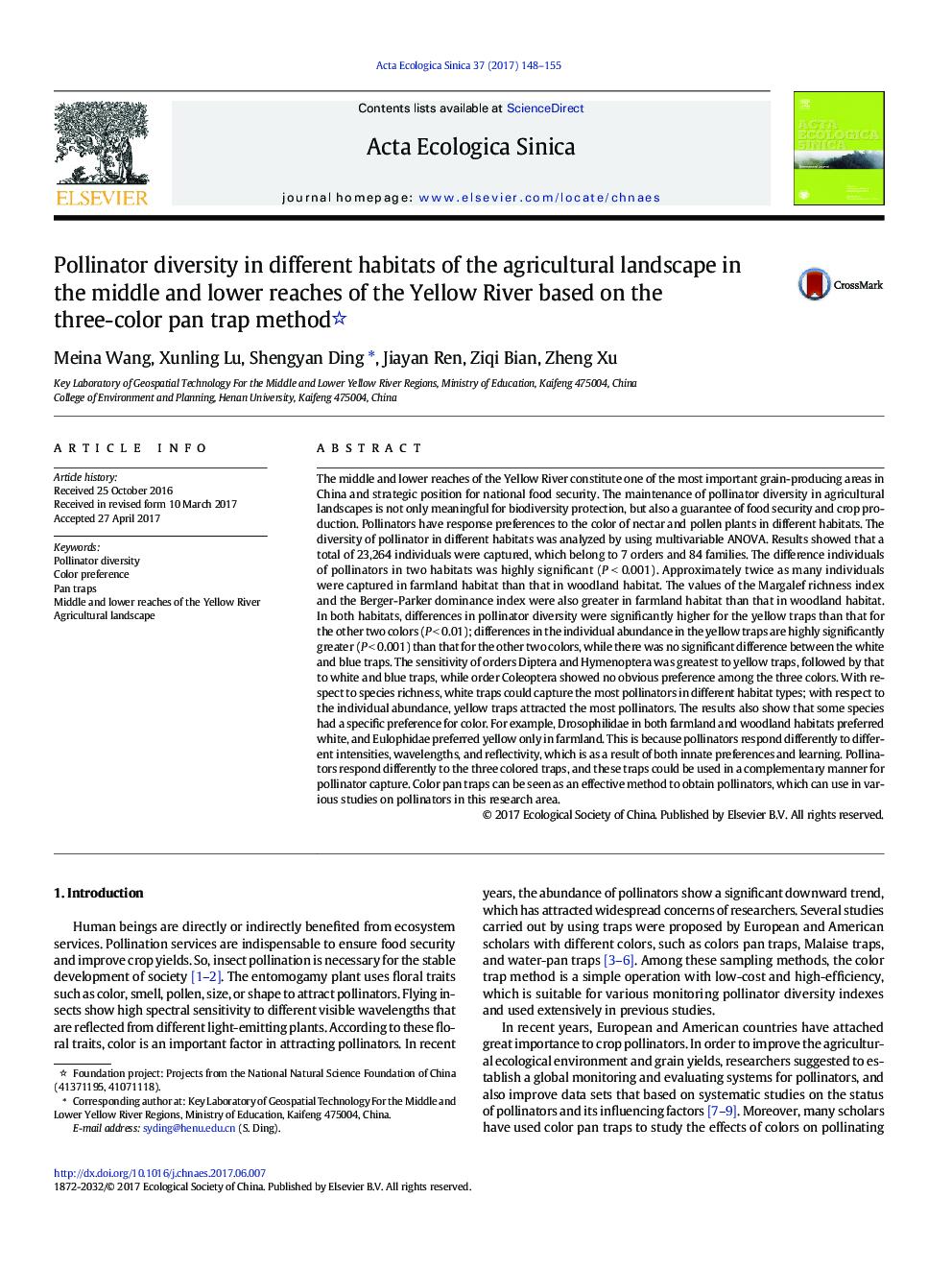| کد مقاله | کد نشریه | سال انتشار | مقاله انگلیسی | نسخه تمام متن |
|---|---|---|---|---|
| 8846373 | 1617674 | 2017 | 8 صفحه PDF | دانلود رایگان |
عنوان انگلیسی مقاله ISI
Pollinator diversity in different habitats of the agricultural landscape in the middle and lower reaches of the Yellow River based on the three-color pan trap method
ترجمه فارسی عنوان
تنوع گرده افشان در زیستگاه های مختلف چشم انداز کشاورزی در میانه و پایین رود زرد بر اساس روش سه تکه تله
دانلود مقاله + سفارش ترجمه
دانلود مقاله ISI انگلیسی
رایگان برای ایرانیان
کلمات کلیدی
تنوع گرده افشانی، ترجیح رنگ، تله پان، میانه و پایین تر از رودخانه زرد، چشم انداز کشاورزی،
موضوعات مرتبط
علوم زیستی و بیوفناوری
علوم کشاورزی و بیولوژیک
بوم شناسی، تکامل، رفتار و سامانه شناسی
چکیده انگلیسی
The middle and lower reaches of the Yellow River constitute one of the most important grain-producing areas in China and strategic position for national food security. The maintenance of pollinator diversity in agricultural landscapes is not only meaningful for biodiversity protection, but also a guarantee of food security and crop production. Pollinators have response preferences to the color of nectar and pollen plants in different habitats. The diversity of pollinator in different habitats was analyzed by using multivariable ANOVA. Results showed that a total of 23,264 individuals were captured, which belong to 7 orders and 84 families. The difference individuals of pollinators in two habitats was highly significant (PÂ <Â 0.001). Approximately twice as many individuals were captured in farmland habitat than that in woodland habitat. The values of the Margalef richness index and the Berger-Parker dominance index were also greater in farmland habitat than that in woodland habitat. In both habitats, differences in pollinator diversity were significantly higher for the yellow traps than that for the other two colors (PÂ <Â 0.01); differences in the individual abundance in the yellow traps are highly significantly greater (PÂ <Â 0.001) than that for the other two colors, while there was no significant difference between the white and blue traps. The sensitivity of orders Diptera and Hymenoptera was greatest to yellow traps, followed by that to white and blue traps, while order Coleoptera showed no obvious preference among the three colors. With respect to species richness, white traps could capture the most pollinators in different habitat types; with respect to the individual abundance, yellow traps attracted the most pollinators. The results also show that some species had a specific preference for color. For example, Drosophilidae in both farmland and woodland habitats preferred white, and Eulophidae preferred yellow only in farmland. This is because pollinators respond differently to different intensities, wavelengths, and reflectivity, which is as a result of both innate preferences and learning. Pollinators respond differently to the three colored traps, and these traps could be used in a complementary manner for pollinator capture. Color pan traps can be seen as an effective method to obtain pollinators, which can use in various studies on pollinators in this research area.
ناشر
Database: Elsevier - ScienceDirect (ساینس دایرکت)
Journal: Acta Ecologica Sinica - Volume 37, Issue 3, June 2017, Pages 148-155
Journal: Acta Ecologica Sinica - Volume 37, Issue 3, June 2017, Pages 148-155
نویسندگان
Meina Wang, Xunling Lu, Shengyan Ding, Jiayan Ren, Ziqi Bian, Zheng Xu,
